La Plata Peak (14,336 ft)
Early Sunday morning, we drove to the La Plata trailhead (on Independence Pass, to do the Northwest Ridge

route). We'd thought about climbing the southwest ridge from Winfield, but had done Belford, Oxford, Missouri, and Huron from that valley, so decided that a different approach might offer a pleasant change of scenery. We found the trailhead 14 miles beyond the turn off of Hwy 24 to Co 82
We arrived at the trailhead at about 5:40am, and surprisingly, parking was hard to find! About a dozen cars were parked there, leaving little room for us. We hit the trail at 5:50am - just as dawn was beginning to approach. With 4,500 feet of elevation to gain and sketchy afternoon weather forecasted, starting early seemed to be in our best interest. Shortly after we broke off the dirt road and started hiking the trail, we encountered the metal and wood bridge that crossed a bit of a chasm. Down below was the roaring, orange colored, arsenic laden water of South Fork Lake Creek. We stopped for a minute or two just to appreciate the power of this creek below shooting through the narrow rock canyon.
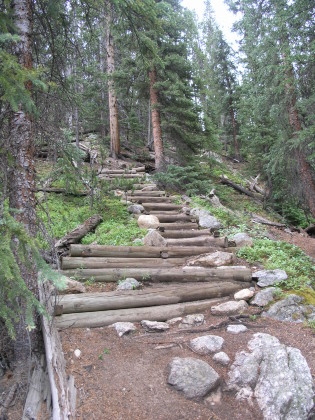
We continued on the gentle trail through the woods, eventually crossing another stream with a small log bridge. Shortly thereafter, the trail became increasingly steep, first climbing upwards on sporadic steps, then a seemingly unending series of log steps placed on the mountainside. The trail first ascends directly alongside the fast flowing creek, but quickly the trail climbs high above the valley floor (as much as 200 feet above it), aided by the stairs indicated before. At times, the trail is a narrow ledge along an inclined valley wall, making for some awkward footing once the rocks and tree roots become wet from rain; all the while you can hear the roaring stream as it drops quickly down in the valley floor below.
Eventually, after about 1.5 miles (at around 10,800 ft), the trail and the stream converge again, and the valley floor begins to level off. Here, the stream quiets down and meanders through willows on the wider valley floor and a view of Seyres Peak (13,738 ft) at the end of the valley opened up. We spotted about a dozen tents scattered throughout this area, mostly on the far side of the stream in the forest - it seemed like a good place to camp and take an early morning on the summit (since the level ground available below at the trailhead is private land). It was now 7:00am.
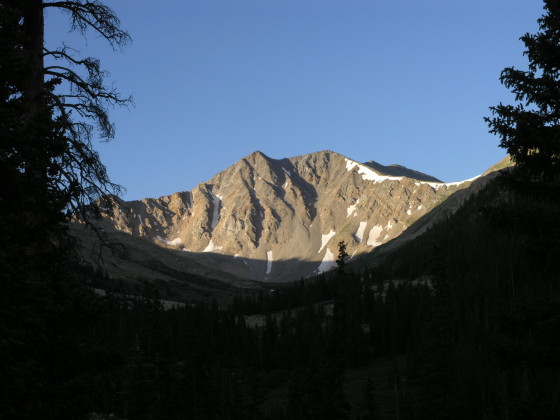
The reprieve from climbing was short lived - after about half a mile of level hiking, the trail began to ascend steeply again up the eastern valley wall, eventually reaching a narrow chute just below treeline with switchbacks zig-zagging up nearly 500 feet. Despite the switchbacks, the climb was still very steep, as each switchback was only about 50 feet long and seemed to gain about 30-40 feet on each turn. As the trail straightened out above treeline, the altitude gain abated a little, giving us a chance to catch our breath. Looking directly above us towards the ridgeline, a number of fantastic (and just a little creepy) rock spires jutted out of the grassy slopes, making for some very interesting scenery along the route.
Eventually, we reached a set of well crafted rock steps that climbed steeply up to the ridgeline. By 8:30am, we were on the ridge (12,750 ft) and finally in the sunshine. We rested for a few minutes, shedding some of warm layers and having a snack. At this point, based on the 14ers.com route description, I knew that the hike was going to get more challenging - which was hard to believe because, to this point, the trail had been pretty aggressive (although, we had a trail - which is really what the challenge is beyond this point). While resting on the ridge, to other hikers caught up with us - the only others we'd seen on the mountain so far.
We resumed hiking towards the large buttress on the ridge. To my surprise, the trail was still very solid, although as we entered the talus, it became harder to find. With some careful route finding (and a few wrong turns here and there), we managed to stay on the solid climbers trail up and around the buttress. It was well marked with cairns and piles of rocks forming a small wall at key switchbacks, making it relatively easy to follow.
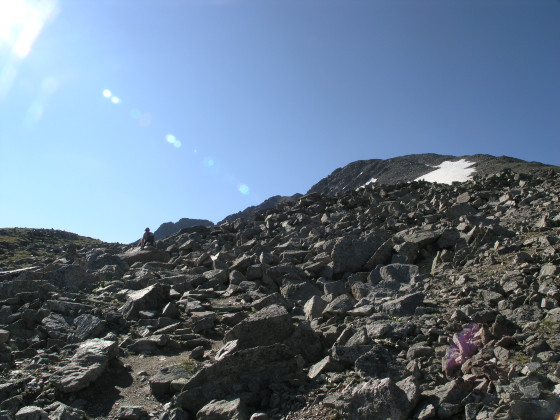
Once above the buttress, the trail disappeared completely and for about the next few hundred feet of climbing, we were basically just rock hopping. There were occasional cairns scattered along the ridge, but finding a good route was still challenging. Thankfully the rock hopping eventually gave way to a decent climbers trail, speeding our ascent (as much as it can be sped up above 13,000ft). The hike was still very tiring, as the climb was steep and rocky, requiring a lot of energy and concentration as to where to step, but the climbers trail made it much more tolerable.
With careful attentiveness to cairns along the way, the trail took us all the way to the junction of the Southwest ridge trail at 14,200 feet (9:50am). As we turned east, a few climbers trails were visible, so we picked the most obvious one to ascend up and over the small false summit and on to the real one. Once atop the ridge, a more obvious trail guided us the last few hundred feet to the summit. We'd reached the summit at 10:10am, 4 hours and 20 minutes after starting.
The clouds, which had been building steadily since around 9:00am, were starting to fill in. Off in the distance, we could see the clouds beginning to billow up into the sky, signaling bad weather wasn't too far off. Unfortunately, this meant that we had just enough time on the summit to snap a few photos and turn around to try to stay ahead of the weather.
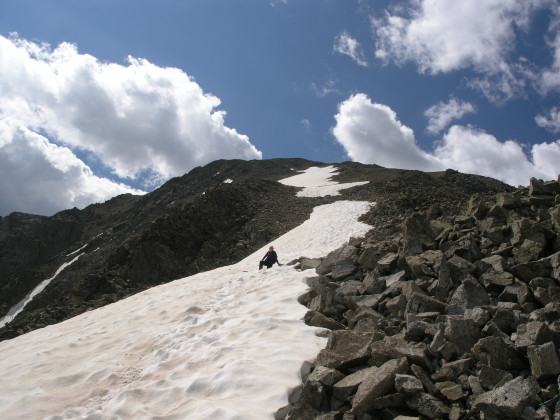
As we came off the summit, we began to pass a number of hikers that had been behind us (probably 20 or so came up the same route as we did) on the ridgeline. The climbers trail was a bit harder to follow on descent, and we lost it a few times. We came to a small snow field at 13,700 ft 10:40am, and decided it offered a much more enjoyable descent, so we glissaded down it to lose about 100 ft in altitude (much to the amusement of some of the hikers still ascending the ridge). Further down, a larger snowfield (which had an unfortunately steep runout into the La Plata basin to the east) was too rough to glissade, but allowed a more consistent footing for descent then the alternative of rock hopping. We resumed rock hopping on the climbers trail around the large buttress, and finally regained the solid trail as we descended the rock steps off the ridgeline.
The clouds were still building overhead, and we were anxious to get back to treeline, so we continued our push without breaks to get down. Most of the trail was not on the top of the ridgeline itself, so had a storm
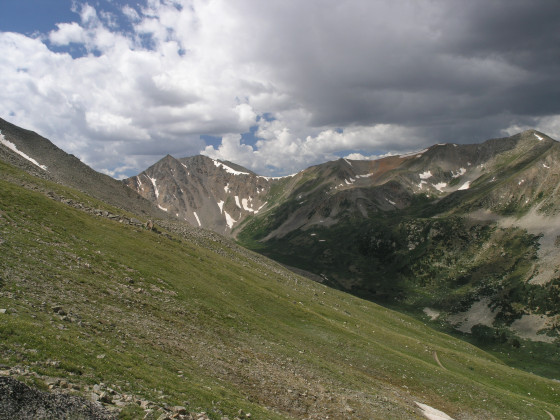
come, we wouldn't necessarily have been the tallest items around - but it's best not to tempt fate. However, once we dropped down onto the grassy slopes again, I felt a bit more exposed, as we didn't have thousands of giant boulders to offer some form of protection (or an alternate target for the lightning). From the ridge, we could see rain engulfing Capitol Peak to the west and heading our way. Once below the ridge, we could see the rain slowly creeping down Independence Pass, so we donned our rain gear and continued heading down the trail. It started raining on us just before we reached treeline at about 11:30am, making the trail slicker and our steps a little more deliberate. The first sound of distant thunder came about noon, once we were below treeline. We continued to hike down in the rain, resting a little easier that we were in the (relative) safety of the trees. We reached the steep steps at about 12:30am, and were back at the trailhead by 1:10pm (after taking a few minutes to take photos of the raging water and an old abandoned cabin off the trail).
A number of friends had described La Plata as being a challenging peak. By all accounts, it's not necessarily longer or steeper than other trails we've done, but this one really wore us down. This was our third 14er of the year (Grays and Huron being the first two), and they were a walk in the park compared to this - mostly because both had a very solid trail all the way to the summit. While this had a solid trail below treeline, it was narrow, sometimes precariously perched on a valley wall, rocky, and tree-root strewn. In my opinion, these factors contributed to the overall difficulty of this hike, considering that on your descent, your legs are usually a bit less responsive, and the trail can lead to a lot of stumbles - this was exacerbated in our case by the rain, which made these roots and rocks very slick. Above treeline, the rock hopping, although sometimes a welcome change from a standard trail-slog, can also be very tiring. The climbers trail helped tremendously, but it's still a steep climb on talus that can sometimes shift under your weight. Of course, all of these conditions were exaggerated in our case because we chose to take only two breaks (due to the incoming clouds) - one on the ridgeline on ascent, and a brief one on the summit. We've both done longer hikes and steeper hikes, but this one was more wearing than we expected. Still a great hike - but I'd consider this route one of the more challenging hikes I've ever done - make sure you give yourself a day off to recover! On the positive side, though, I've never seen so many marmots or pikas on any hike - so the wildlife certainly seems to enjoy this area!